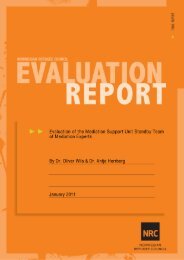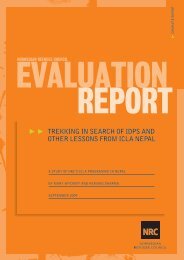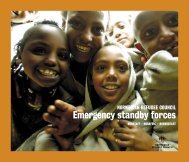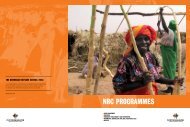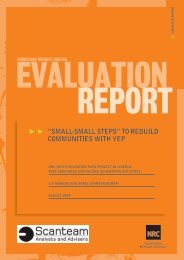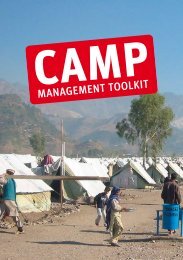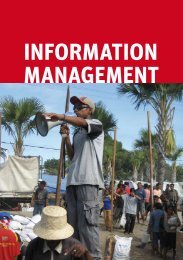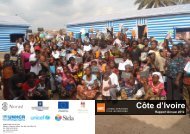evaluation of general food distribution in northern uganda: gulu ...
evaluation of general food distribution in northern uganda: gulu ...
evaluation of general food distribution in northern uganda: gulu ...
You also want an ePaper? Increase the reach of your titles
YUMPU automatically turns print PDFs into web optimized ePapers that Google loves.
3 NORTHERN UGANDA – A CHALLENGING CONTEXT3.1 Poverty & Conflict <strong>in</strong> Northern UgandaThe districts <strong>of</strong> Amuru, Gulu, Kitgum and Pader <strong>in</strong> the Acholi Sub region <strong>in</strong> Northern Ugandahave been at the centre <strong>of</strong> a conflict between the Government <strong>of</strong> Uganda (GOU) and theLord’s Resistance Army (LRA) for more than 22 years. The protracted conflict has lead tomassive <strong>in</strong>ternal population displacements <strong>in</strong> Northern Uganda. At the height <strong>of</strong> the<strong>in</strong>surgency (2002 -2004) nearly 2 million people were forced to live <strong>in</strong> crowded camps. In theAcholi region alone, more than a million people were liv<strong>in</strong>g <strong>in</strong> 112 camps. Insecurityhampered free movement, to the effect that people were conf<strong>in</strong>ed <strong>in</strong> camps for years 7 . Thiscontributed to mak<strong>in</strong>g North Uganda the third, among the 10 worst <strong>in</strong>ternal displacementsituations <strong>in</strong> the world 8 .The war had a direct impact on people’s lives and ability for survival. Over 20.000 childrenhave been abducted by the LRA and forced <strong>in</strong>to the rebel forces as child soldiers. Abductedgirls and young women were subjected to sexual enslavement and forced to serve as wivesto LRA rebels 9 . In addition to repeated gross human rights violations 10 , countless lives havebeen lost and assets, social <strong>in</strong>frastructure and livelihoods destroyed. Health <strong>in</strong>dicators dur<strong>in</strong>gmany years reflected discourag<strong>in</strong>g trends. Between 1995 and 2000 <strong>in</strong>fant mortality <strong>in</strong>creasedfrom 81 to 88 deaths per 1000 live births. Mortality amongst children under the age <strong>of</strong> five<strong>in</strong>creased from 147 to 152 per 1,000 deaths 11 , stunt<strong>in</strong>g reached the level <strong>of</strong> 39% and by early2000 the global acute malnutrition rates reached an alarm<strong>in</strong>g 20% <strong>in</strong> many parts <strong>of</strong> theNorth. 12Northern Uganda accounts for over 20% <strong>of</strong> Uganda’s arable land. Traditionally this area wasknown as the breadbasket <strong>of</strong> Uganda as it produced a <strong>food</strong> surplus that was sold <strong>in</strong> otherparts <strong>of</strong> the country. However, the impact <strong>of</strong> the conflict changed this favourable situation,and from be<strong>in</strong>g farmers and livestock herders, people became largely dependent onhumanitarian assistance for their survival. The conflict has contributed to high poverty levels,which range between 61 – 70% and are more than double the national average <strong>of</strong> 31% 13 .The war widened the poverty gap between the North and the rest <strong>of</strong> the country from 17% <strong>in</strong>1992 to 30% <strong>in</strong> 2005/06. Today, almost half (44.3%) <strong>of</strong> the poorest 20% <strong>in</strong> Uganda live <strong>in</strong>Northern Uganda, many <strong>of</strong> whom are extremely vulnerable <strong>in</strong>dividuals 14 .With time the humanitarian crisis has drawn <strong>in</strong>ternational attention. Resourc es channelledtowards emergency assistance have grown substantially from USD 42 million <strong>in</strong> 2002, USD204 million <strong>in</strong> 2006 and close to USD 300 million <strong>in</strong> 2007. 15 Although the regularity <strong>of</strong> thehumanitarian assistance varied due to the security situation, provision <strong>of</strong> basic socialservices, <strong>food</strong>, medic<strong>in</strong>e and other support services have been extended to the IDPs.3.2 Peace Process & ReturnsThe security situation <strong>in</strong> Northern Uganda has improved significantly s<strong>in</strong>ce the sign<strong>in</strong>g <strong>of</strong> acessation <strong>of</strong> hostilities agreement <strong>in</strong> August 2006 and the peace talks <strong>in</strong> Juba. The respiteimproved mobility, access for humanitarian assistance, <strong>in</strong>creased movement, access to land,and sparked the re-emergence <strong>of</strong> economic life <strong>in</strong> parts <strong>of</strong> the region. However, while the7EU, 2007: Northern Uganda Agricultural Recovery Programme: Identification Mission Report8IDMC/NRC: Internal Displacement - Global Overview <strong>of</strong> Trends and Developments <strong>in</strong> 20059Fe<strong>in</strong>ste<strong>in</strong> International Center: Movement on the Marg<strong>in</strong>s: Livelihoods and Security <strong>in</strong> Kitgum District, Northern Uganda10Abductions, conscription, mutilations, rape and other forms <strong>of</strong> sexual violence,11A UNICEF situation analysis report <strong>of</strong> 2005 states that the dire situation resulted <strong>in</strong> over 400 children under the age <strong>of</strong> fivewould die each week from easily preventable diseases <strong>in</strong>clud<strong>in</strong>g malaria, diarrhoea, anaemia and malnutrition.12WFP PRRO 2005-2008132005/06 Uganda National Household Survey14Orphans, widows, children head<strong>in</strong>g households and the elderly15UNIRIN, November 200710





